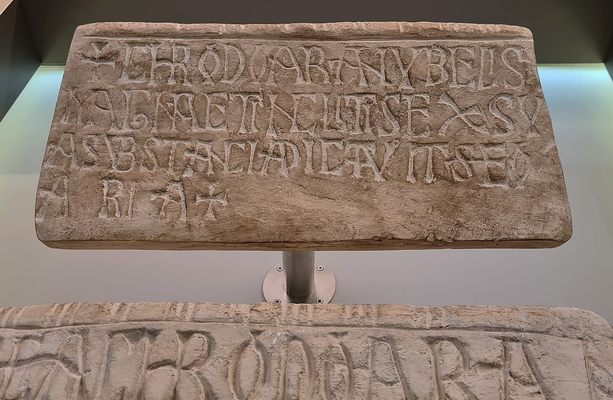About
Located a little over an hour's drive southeast of Brussels, Amay is a town in the Meuse valley. The town is dominated by the three bell towers of its collegiate church, which is dedicated to Sainte-Ode and Saint-Georges. On January 22, 1977, at 4:45 p.m., a Merovingian stone sarcophagus was discovered in the choir. The three archaeologists present that day immediately realized the importance of their discovery. They removed the carved face from the lid. Among historians in neighboring countries, news of the discovery spread rapidly. More than 50 years later, the extraordinary nature of the discovery has not diminished at all.
After studying 1,570 Merovingian sarcophagi from Western Europe (the largest study ever carried out), archaeologist Laure-Anne Finoulst confirmed the uniqueness of the Amay sarcophagus in 2022. Firstly, no other sarcophagus combines a sculpted program, a human representation and a text at the same time; Secondly, it is the only known female representation in Merovingian sculpture and, the largest known human representation. In addition, one of the faces contains a text of about 10 words, divided into four lines—there is no other sculpture known that contains so many words. Furthermore, this text contains all the main points of Saint Ode's life: the Merovingian princess and the local saint are the same person. Finally, the presence of sharp-edged interlacing would prove that Irish evangelizing monks were visiting our region at that time (their presence is known from texts, but no material traces have yet been discovered).
The sarcophagus was probably made around 730, when the saint's bones were exhumed to re-establish her sanctity. The purpose of this political act was probably the glorification of the descendants of her family. The sarcophagus probably remained visible until the 13th century. This is attested to by some of the debris found inside. As it contained the body of a saint, it was buried intact under the choir of the church. This burial followed a change in the presentation of relics: the bones had already been transferred to a shrine in the 12th century (only the sprockets remain, preserved in the British Museum in London and in the Walters Art Museum in Baltimore in the United States). For some unknown reason, a second shrine was built between 1240 and 1250. It has been preserved to this day in the chapter house, just behind the choir. The analyses carried out when the shrine was opened for the last two times have confirmed that it contained the bones of a Frankish woman.
It is reasonable to assume that Chrodoara's relics are actually preserved in the shrine: she still rests in the collegiate church she founded. This is an exceptional case. Notably, all reliquaries containing her bones have been identified and two are still preserved in the building. They are classified as Treasures of the French Community of Belgium.
Related Tags
Know Before You Go
The sarcophagus is in the place where it was found, visible under a pane of glass in the floor of the choir of the Collegiate Church of Amay.
The Collegiate Church is part of the Open Church network. The opening hours can be found on the web site. Entrance is free of charge and there are always volunteers on hand to give explanations.
Community Contributors
Added By
Published
October 15, 2024
Sources
- https://www.europeana.eu/en/item/322/Museu_ProvidedCHO_Mus_es_Royaux_d_Art_et_d_Histoire_126453
- https://www.medieval.eu/merovingian-sarcophagus-chrodoara-amay/
- https://openchurches.eu/fr-be/edifices/saint-georges-et-sainte-ode-amay
- https://nordoc.hypotheses.org/20842#:~:text=FINOULST%20Laure-Anne.%20Les%20sarcophages%20du%20Haut%20Moyen%20%C3%82ge%20en%20Gaule
- https://www.kikirpa.be/fr/objets-du-patrimoine/le-sarcophage-de-sainte-chrodoara
- https://balat.kikirpa.be/photo.php?path=X040046&objnr=10072390
- https://patrimoineculturel.cfwb.be/patrimoines-en-fwb/inventaire-du-patrimoine-mobilier-protege/pcmdetail/fwbpci-fiche/carnaval-de-malmedy/





































